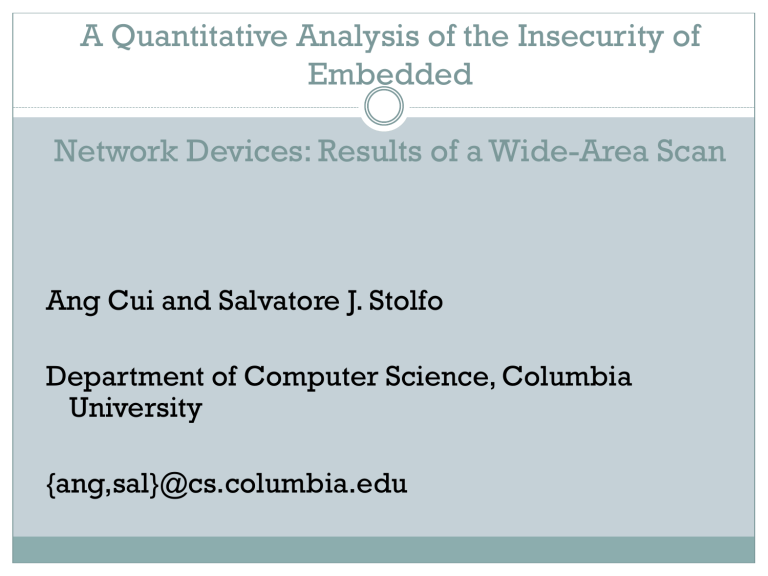They Can Hear Your Heartbeats

A Quantitative Analysis of the Insecurity of
Embedded
Network Devices: Results of a Wide-Area Scan
Ang Cui and Salvatore J. Stolfo
Department of Computer Science, Columbia
University
{ang,sal}@cs.columbia.edu
Motivation
Embedded network devices have become an ubiquitous fixture in the modern home, office as well as in the global communication infrastructure
Widely deployed and often misconfigured, embedded network devices constitute highly attractive targets for exploitation
Questions
How have embedded devices been exploited in the past?
How feasible is large scale exploitation of embedded devices?
Questions
How can we quantitatively measure the level of embedded device insecurity on a global scale?
Questions
How can compromised embedded devices be used to benefit malicious attackers?
How many vulnerable embedded devices are there in the world?
What are they?
Where are they?
What are the most efficient methods of securing vulnerable embedded devices?
Technique
Scan the entire internet
First, nmap is used to scan large portions of the internet for open TCP ports 23 and 80. The results of scan is stored in a SQL database.
Identify device type.
Use default passwords to try to log into embedded devices by verification profile
Gain root access
Each scan takes approximately four weeks and involves two or three sweeps of the entire monitored IP space
Increase likelihood of getting connection
Allow for comparison over time
Ethical Concerns
Make sure we are not overloading networks
Make it easy to opt out of research
Have secondary checks (Columbia University
NOC)
Rigid security policies for protecting data
Sensitive experimental data is purged from the production database regularly
Transferred to an IronKey [4] USB stick for encrypted offline storage
Results
Identified approximately 1.1 million vulnerable devices. (as of now the paper cites 540,000)
Over 96% of such accessible devices remain vulnerable after a 4-month period
300,000 vulnerable embedded devices within two
ISP networks in Asia.
Residential ISPs constitute over 68% of the entire vulnerable population.
DDOS
3 types of devices are 55% of vulnerable
This could be used for massive DDOS attack
Office Espionage
HP JetDirect Printer Servers represent 44,000 of vulnerable devices
Located in 2505 unique organizations
This allows hackers to see data and dataflow
END
They Can Hear Your Heartbeats:
Non-Invasive Security for
Implantable Medical Devices
S H Y A M N A T H G O L L A K O T A , H A I T H A M H A S S A N I E H ,
B E N J A M I N R A N S F O R D, D I N A K A T A B I , A N D K E V I N F U
A C M S I G C O M M 2 0 1 1
Implantable Medical Devices (IMD)
Cardiac
Defibrillators
Neurostimulator s
Cochlear
Implants
Wireless Interaction in IMD
Wireless Interaction in IMD
Pro: Safety and Cost
Easier communication with implant
Remote monitoring
Reduces hospital visits by
40% and cost per visit by
$1800 [Journal of the
American College of
Cardiology, 2011]
Con: Security and Privacy
Passive attack:
Eavesdrop on private data
Active attack:
Send unauthorized commands
Possible Security Measurements
Cryptography?
Problems
1) In emergencies, patient may be taken to a foreign hospital where doctors do not have the secret key
2) Millions of patients already have implants with no crypto; would require surgery to replace
Ideal Solution
Cryptography? => The “Shield”
Problems
1) In emergencies, patient may be taken to a foreign hospital where doctors do not have the secret key => can be non-intrusively disable
2) Millions of patients already have implants with no crypto; would require surgery to replace => external security module
Traditional System
Shield: Secure Legal Communication
Use encryption
Shield acts as
proxy
Shield: Jam Illegal Communication
Turn off therapy
Implant ID
• Shield listens on medium
• Shield jams unauthorized commands
Implants can’t decode or react to illegal commands
Technical Issue
Needs to be able to Tx (jam) and Rx at the same time.
wavelength
≈ 40 cm
2
Needs to be small enough to be portable.
The “Antidote”
Solution
w/o antidote: 50% BER w/ antidote: 0.2% packet loss
Implementation
USRP2 (Universal Software Radio Peripheral)
Antenna *2
FPGA
Ethernet interface
SD card reader
Evaluation
• IMD: Medtronic TM cardiac implants
• Legal user: Medtronic TM IMD programmer
• Attacker: USRP2
• Shield: USRP2
• Human body: bacon & beef
Test Bed
IMD & Shield fixed in one place
20 locations for attacker to test
20cm
30 m
Phase1: Passive Eavesdrop
Worst case scenario
Attacker is only 20cm away from IMD
Attacker
1
0,8
0,6
0,4
0,2
0
0
Rando
Jammed
0,2 0,4 0,6 0,8
BER
1
Shield
1
0,8
0,6
0,4
Average loss rate
0.2%
0,2
0
0 0,005 0,01 0,015 0,02 0,025
PLR
Phase2: Active Attack
Simulating two kinds of attackers
1) Off-the-shelf IMD programmer
2) Self-modified programmer with x100 transmission power
Phase2-1: Off-the-shelf Attacker
1
0,8
0,6
Less than
14 meters w/o Shield w/ Shield
0,4
0,2
0
1 2 3 4 5 6 7 8 9 10 11 12 13 14 15 16 17 18
Location ID
Any attack successful
No attack successful
14 m
Without the
Shield
Any attack successful
No attack successful
20 cm
With the
Shield
Phase2-2: x100 Power Attacker
Too powerful, cannot jam it due to limited battery power of Shield
However, can warn the wearer by beeping and/or vibration to leave the location
Phase2-2: x100 Power Attacker
Any attack successful
No attack successful
Without the
Shield
27 m
Any attack successful
No attack successful
With the Shield
Phase2-2: x100 Power Attacker
Cannot totally eliminate the hazard
But,
Raise the bar of active attack
Provide detection of hazard
Conclusion
First to secure medical implants without modifying them
Other applications in RFIDs, small low-power sensors, legacy devices
Convergence of wireless and medical devices open up new research problems
Few Comments (kcir)
Meticulous foot notes
Kind of verbose/repetitive
DoS -> wears out the battery
Technical invention in disguise of an application work, incurs more attention






